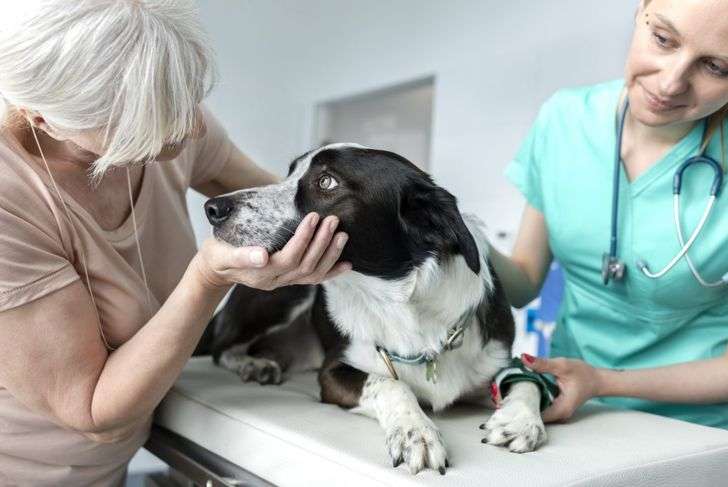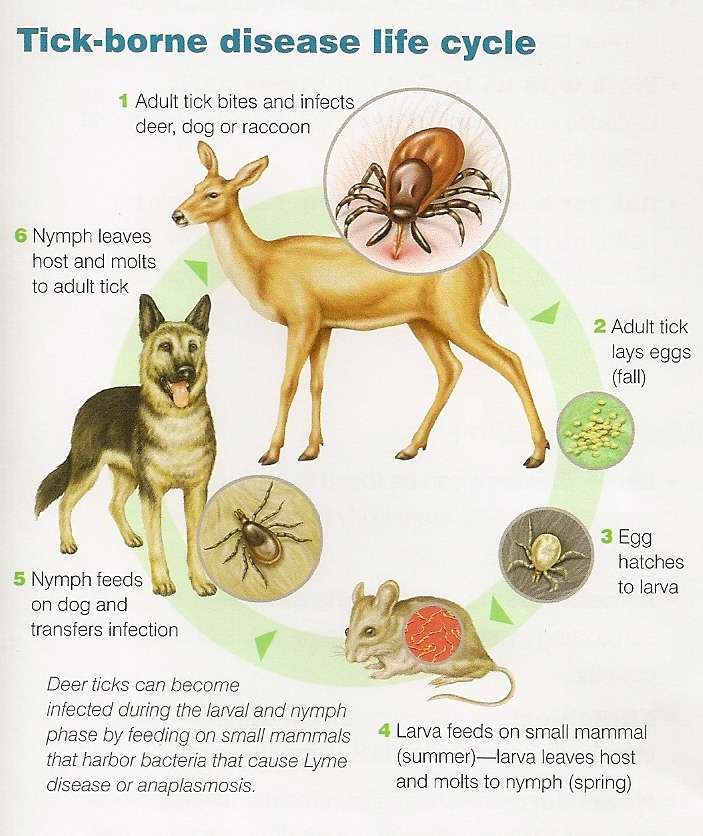Treatment Of Lyme Disease
Lyme disease symptoms in dogs are treated with tetracycline or penicillin-based antibiotics. Most dogs recover in about two weeks, but in some cases antibiotics must be administered for thirty days or longer. Some dogs experience a recurrence of Lyme disease symptoms within a few weeks or months of finishing treatment. These dogs will need to undergo the treatment program again.
What Are The Chances Of Your Dog Getting Lyme Disease
How common is Lyme infection in dogs? The true prevalence of Lyme infections in dogs is unknown, but informal surveys and anecdotal reports from veterinary clinicians practicing in hot-spot Lyme areas indicate that between 10-60% of dogs not vaccinated for Lyme may test positive for Borrelia burgdorferi.
How Can Pet Parents Prevent Canine Lyme Disease
Testing is required to diagnose a case of Lyme disease in dogs. Your veterinarian will use a blood test to confirm the presence of antibodies associated with the disease. Keep in mind that it takes at least four weeks for these antibodies to show up on a test. If your dog has recently suffered a tick bite, a test administered in the first four weeks wont offer any indication of whether your dog has Lyme disease or not.
Veterinarians will combine this test with their own physical evaluation of your dog when making a diagnosis. Once a positive test is confirmed, your dogs vet will likely prescribe antibiotics to eliminate the bacteria at the root of their condition, although specific treatment protocols may depend on the health of your dog.
Even if your dog has been diagnosed with Lyme disease in the past, your veterinarian may recommend vaccination to prevent additional cases of Lyme disease in the future. This vaccination is performed in two phases, with an initial vaccination and another booster administered several weeks later. It is recommended that dogs receive an annual booster to maximize the efficacy of the vaccination. Beyond a vaccine, you can take other preventative measures by giving your dog preventative tick medications, as well as checking them regularly for ticks latched onto their skin. The risk of contracting Lyme disease increases the longer a tick is attached, so prompt identification and removal will reduce the likelihood of canine Lyme disease.
You May Like: Is There A Vaccine Available For Lyme Disease
What Happens If Lyme Disease Goes Untreated
Treating Lyme disease in a timely manner is absolutely crucial to your dogs health, otherwise its complications can cause even more severe problems. Dr Muller further warns, Lyme disease can lead to serious damage of the heart, nervous system, and kidneys.
Dogs who are not treated for Lyme disease may find themselves with any of the following conditions:
- Inflammation of the kidneys, and in severe cases, kidney failure. Symptoms of this kidney failure include increased thirst and urination, vomiting, diarrhea, swelling of extremities, and lack of appetite. This can be fatal.
- Chronic pain from arthritis
- Heart problems
- Seizure disorders or facial paralysis as a result of damage to the nervous system
Many of these issues, if left untreated, can be potentially fatal, so the answer is clear. If your dog is diagnosed with Lyme disease, take care of it as soon as you possibly can.
Things You Need To Know About Lyme Disease In Dogs

May 4, 2017 / 4:49 PM / CBS News
The arrival of springtime means Lyme disease is again resurfacing as a concern on the radar screens of people across the country. So, if you go for a hike or take a walk through long grass, chances are that you’ll check yourself for ticks afterward.
But our pets are constantly lounging and playing in conditions conducive to tick exposure, and how often do we thoroughly check them? If the answer to that question isn’t “every day,” then experts say it’s not enough.
“The most important thing is to stress prevention,” explains Dr. Richard Goldstein, chief medical officer at New York City’s Animal Medical Center. “This is something that we want to prevent from happening the first time. Once you’re infected with these organisms, the chance is you might be infected for life. So, you just have to really go through hair by hair. Look at the paws. Look at the ears. Look around the muzzle, the face. If you do it every day, you’re not going to get a big accumulation.”
Occasionally, however, a dog can pick up hundreds of ticks on a single outing and the result can be disgusting, to say the least.
“Sometimes if a dog walks through a place where ticks were molting into nymphs, you might find 200 tiny ticks on your dog,” explains Dr. Goldstein. “That’s scary when that happens.”
But that’s not the only scary reality of Lyme that pet owners should heed.
You May Like: Lyme Nephritis Symptoms In Dogs
What Are Symptoms Of Lyme Disease In Dogs
When it comes to Lyme disease, dogs are often asymptomatic . However, here are some common signs of Lyme disease in dogs:
- Fever
- Lack of appetite and depression
- General discomfort or malaise
- Lameness due to inflamed joints
- Sensitivity to touch
- Difficulty breathing
If your dog is displaying symptoms of Lyme disease, contact your vet to schedule an examination. Left untreated, signs of Lyme disease in dogs can progress to kidney failure and even be fatal in severe cases. Serious neurological impacts and cardiac effects may also take place due to untreated Lyme disease.
Lyme Disease In Dogs: Symptoms And Treatment
Lyme disease in dogs is one of the most common tick-transmitted diseases in the world, but it only causes symptoms in 5-10% of affected dogs. So some dogs may have it, but never show symptoms.
Transmission of Lyme disease has been reported in dogs throughout the United States and Europe, but its most prevalent in the upper Midwestern states, the Atlantic seaboard and the Pacific coastal states.
However, the disease is spreading and becoming more common throughout the United States. Heres some info about the causes and prevention of Lyme disease, as well as the symptoms you should look for and treatment options.
You May Like: Can Lymes Disease Affect Your Liver
Anorexia And Digestive Tract Upset
Lyme disease causes anorexia, which can manifest as a decreased appetite to the degree that substantially less food is consumed, or all meals or treats may be completely refused.
Anorexia can be caused by hyperthermia , arthritis , myalgia , renal failure, or other ailments associated with infection by Borrelia burgdorferi.
Besides eating less or refusing food, dogs infected with Lyme disease can have other digestive tract upset such as emesis or diarrhea related to hyperthermia, renal failure, or other health problems.
Image:Monika Wisniewska/Shutterstock
What Is The Staging For Lyme Disease
Lyme disease is categorized into three stages:
Read Also: Lyme Disease High Blood Pressure
Can An Animal Get Infected Despite Being Vaccinated
Yes. This has been observed that some animals can still get infected after Lyme vaccination. This can be due to a low immune response of the respective animal and/or a very high exposure rate or Lyme prevalence in the area where the animal lives. A yearly check of the OspA titer is recommended for a vaccinated animal to ensure that the animal responded with high OspA antibodies to vaccination. Please indicate the name of the vaccine and when it has been last applied on the accession form.
What Is Lyme Disease
Lyme disease is an illness spread by infected ticks. It can affect dogs, people, horses and very occasionally, cats. Lyme disease is caused by a bacteria that attacks tissues around the body, most commonly the joints, but also organs such as the kidneys. Lyme disease spreads when an infected tick attaches and feeds, so keeping your pet up to date with a product that kills or repels ticks is the best way to prevent it.
Read our article Ticks on pets to find out more about ticks.
Oscar the dog picked up a tick on his head while he was walking in long grass.
Also Check: How To Treat Long Term Lyme Disease
Treatment Of Lyme Disease In Dogs
Four weeks of Doxycycline is the most common course used to treat Lyme and other tick-borne diseases . If dogs have been showing clinical signs, they often perk up and improve in a matter of days, but its important to give the full course of treatment. If dogs arent treated, or treatment has been delayed due to unknown diagnosis or other complications, they may continue to have issues for life
If specific organs are affected, more involved testing may be performed, and other treatments prescribed by your vet.
Lyme Disease Vaccination Controversy

Few holistic veterinarians recommend the Lyme disease vaccine, even in dogs that live where Lyme disease is widespread. Its side effects are so severe, says Beverly Cappel, DVM, that I would much rather treat the disease itself. I dont recommend the vaccine, dont carry it, and never use it. When it first came out, we treated dogs for seizures, kidney failure, paralysis, stiff neck, and autoimmune bleeding disorders. Some dogs died and some were permanently damaged. Vaccines dont always work, so a dog thats supposedly protected may get the disease anyway. The newer vaccine causes fewer side effects, but it still has some. No matter how you look at it, I think the risks of vaccination far outweigh the benefits.
Even the traditional veterinary medical community has some issues with the Lyme vaccine.
At the University of California at Davis Veterinary Medical Teaching Hospital , the routine vaccination of household dogs for Lyme disease is not recommended. According to the UCD VMTH Vaccination Protocol for Dogs and Cats, Lyme Disease is not a proven problem in California, therefore, most dogs are at low risk. Moreover, there is no evidence at this time that infection leads to any significant chronic disease problem in dogs or that infected dogs are public health risks. Vaccine reaction problems occur occasionally and may outweigh health benefits. We do not stock Lyme Disease vaccine.
You May Like: Can Lyme Disease Cause Asthma
Treatment For Lyme Disease In Dogs
Veterinarians treat dogs with Lyme disease through a combination of medical therapy and supportive care. A 4-to 6-week course of antibiotics will be prescribed for dogs with clinical signs of Lyme disease, as well as for dogs that have a high antibody level, even if they are asymptomatic. Many owners see improvement within a few days. However, a second round of antibiotics is often required, as the infection may persist through the first round of treatment.
Severe cases of Lyme disease will acquire additional therapy to treat affected kidneys, heart, or nerves, along with supportive care like intravenous fluids. Re-checking blood work is recommended six months after completing antibiotic therapy to determine if treatment has been successful.
There is some debate within the veterinary community as to whether dogs should be treated if they test positive for Lyme disease but are asymptomatic and have a low antibody level. Your veterinarian will speak to you about different options so that you can come up with the best treatment plan for your dog.
Lyme disease can stay in your dogs body even with antibiotics. In these cases, the disease often flares up when a dogs immune system is suppressed or weakened, such as during periods of stress. The same antibiotic can be used to treat repeated recurrences of Lyme disease. Unlike other types of infections, the lingering infection is not a direct result of antibiotic resistance.
What Are The Signs And Symptoms In The Three Stages Of Lyme Disease
The stages of Lyme disease can overlap with each other, and patients may not go through all three stages. The symptoms vary depending on the duration and location of the infection.
Early localized Lyme: This stage occurs within one to 30 days of the tick bite and is characterized by a bullseye rash at the site of a tick bite. This rash is the classic first sign of an infection.. During this stage, the infection has not spread throughout the body and is curable.
Prominent additional signs and symptoms at this stage are:
- Multiple rashes
Late disseminated Lyme: If Lyme disease is not treated effectively or left untreated in the first two stages, then it may progress to a chronic stage known as the late disseminated stage. This stage may occur months to years after a tick bite. Bacteria have spread throughout the body and patients develop chronic arthritis of one or a few joints and/or heart or nervous system symptoms. Some of the prominent signs and symptoms include:
Don’t Miss: Lyme Disease Flare Up Symptoms In Humans
How Likely Is It That Your Dog Will Get Lyme Disease
The Borrelia burgdorferi bacteria found in ticks causes flu-like symptoms. Dr Raus research shows that about a third of ticks carry this bacteria species meaning that if a tick bites your dog, its only 33% likely to carry the B burgdorferi bacteria.
If the bite is from an infected tick, then your dog may develop flu-like symptoms. He may also develop a rash at the site of infection.
This is the first stage of Lyme disease.
Dr Rau and other researchers estimate that only 10% to 20% of tick bites will lead to Stage 1 Lyme Disease. But if left untreated, 30% of Stage 1 cases will lead to Stage 2. This is where bacteria can infect the skin, joints, kidneys and sometimes the heart.
So that means your dog has about a 1% to 2% chance of Stage 2 Lyme Disease the kind of Lyme disease that can make him very sick.
Stage 3 Lyme is the chronic stage. This stage can begin months or even years after infection.
The most common symptoms are joint and muscle pain. Only 1% of stage 2 cases of Lyme progress to Stage 3. This mirrors research done in dogs.
Are Humans At Risk
Can you catch Lyme disease from your dog? No. Dogs cannot directly infect people and Lyme disease cant be transmitted from one pet to another pet or from pets to humans. The only way Lyme Disease is spread is through tick bites. That being said, if a tick is on your dogs fur and it then comes into your house, theres a possibility that it could get on you as well.
In order to avoid exposure to tick bites, as a dog owner, you can also avoid the woods, tall grasses, and bushes, wear long pants, and check you and your dog for ticks each time you leave the outdoors.
Also Check: What Happens When You Get Lyme Disease
How Long After Treatment Should The Horse/dog Be Re
Antibodies decrease slowly but gradually after the pathogen is cleared from the hosts circulation. Re-testing should not be performed too early. For horses/dogs with positive values for antibodies to OspF but negative values for antibodies to OspC , retesting should be done 3 months after the treatment was started. For horses with a positive OspC antibody value retesting can be done 6-8 weeks after the treatment started. At the time of retesting, a decrease of antibody levels can be expected in successfully treated animals. Serum antibodies may not have completely disappeared at this time. However, they should have dropped by about 40% of the original positive value.
Is There A Vaccine That Will Protect My Dog From Lyme Disease
A safe and generally effective vaccine is available for protecting dogs against Lyme disease. This vaccine is initially given twice, at two- to four-week intervals.
“Annual revaccination is necessary to maintain immunity.”
Annual revaccination is necessary to maintain immunity. Vaccination against Lyme disease will be determined by your pet’s lifestyle and individual risk assessment. Be sure to discuss any questions you may have regarding the type and frequency of vaccination with your veterinarian.
| Contributors: Ryan Llera, BSc, DVM Ernest Ward, DVM |
You May Like: Signs And Symptoms Of Lyme Disease In Child
Sign Up For Our Newsletter
Disclaimer: The above material is provided for information purposes only. The material is not nor should be considered, or used as a substitute for, medical advice, diagnosis, or treatment, nor does it necessarily represent endorsement by or an official position of Global Lyme Alliance, Inc. or any of its directors, officers, advisors or volunteers. Advice on the testing, treatment or care of an individual patient should be obtained through consultation with a physician who has examined that patient or is familiar with that patients medical history. Global Lyme Alliance, Inc. makes no warranties of any kind regarding this Website, including as to the accuracy, completeness, currency or reliability of any information contained herein, and all such warranties are expressly disclaimed.
Treating Dog Lyme Disease

If the diagnosis is Lyme disease, your dog will be treated as an outpatient unless their condition is unstable . Doxycycline is the most common antibiotic that is prescribed for Lyme disease, but other antibiotics are also effective.
Treatment usually takes at least 4 weeks, and longer courses may be necessary in some cases. Your veterinarian may also prescribe an anti-inflammatory if your dog is especially uncomfortable.
Unfortunately, antibiotic treatment does not always completely eliminate the infection from Borrelia burgdorferi bacteria. Symptoms may resolve but then return at a later date, and the development of kidney disease in the future is always a concern.
Administering the antibiotics properly to your dog reduces the likelihood of chronic consequences.
Improvement in sudden inflammation of the joints caused by Borrelia should be seen after 3-5 days of antibiotic treatment. If there is no improvement within 3-5 days, your veterinarian will want to reevaluate your dog.
Also Check: East Lyme Homes For Rent